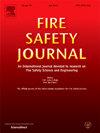Experimental study to assess the impact of different connection types on the fire resistance of composite concrete-topped CLT slabs
IF 3.4
3区 工程技术
Q2 ENGINEERING, CIVIL
引用次数: 0
Abstract
This paper summarizes the results of an experimental study of fire resistance of composite concrete-topped cross-laminated timber (CT-CLT) slabs exposed to fire at their soffit. Six composite CT-CLT slabs and one untopped CLT slab were tested under ISO 834 standard fire exposure while subject to an applied load equal to 20 % of the slab ultimate capacity. Test variables included the type and configuration of shear connection between the topping and CLT. Large bending deflections were observed as the slabs reached their fire resistance. Although the untopped CLT slab exhibited a fire resistance of only 16 min, all CT-CLT exhibited fire resistance greater than 1 h. The improved behavior is attributed to the stiffer CT-CLT behavior. CT-CLT slabs exhibited delamination of the lowermost layer of the CLT following through-layer charring. Observed charring rates were approximately 46 mm/h. Observed charring depths were well-predicted by existing design standard-recommended equations. Importantly, the interface between the concrete topping and CLT remained close to 30 °C and never exceeded 65 °C in any test. This is a promising result for employing adhesive systems to affect composite behavior between the topping and CLT.
评估不同连接类型对复合混凝土顶 CLT 板耐火性影响的实验研究
本文总结了一项关于混凝土加顶交叉层压木材(CT-CLT)复合楼板的耐火性能的实验研究结果。在 ISO 834 标准火灾暴露条件下,对六块复合 CT-CLT 板和一块无顶 CLT 板进行了测试,施加的荷载相当于板极限承载力的 20%。测试变量包括顶板和 CLT 之间剪切连接的类型和结构。当楼板达到耐火极限时,会出现较大的弯曲挠度。虽然未封顶的 CLT 板的耐火时间只有 16 分钟,但所有 CT-CLT 板的耐火时间都超过了 1 小时。CT-CLT 板在通层炭化后,CLT 的最下层出现分层。观察到的炭化速度约为 46 毫米/小时。观察到的炭化深度完全符合现有设计标准推荐公式的预测。重要的是,在任何测试中,混凝土面层和 CLT 之间的界面温度都保持在 30 °C 附近,从未超过 65 °C。对于采用粘合剂系统来影响顶层和 CLT 之间的复合行为来说,这是一个很有前景的结果。
本文章由计算机程序翻译,如有差异,请以英文原文为准。
求助全文
约1分钟内获得全文
求助全文
来源期刊

Fire Safety Journal
工程技术-材料科学:综合
CiteScore
5.70
自引率
9.70%
发文量
153
审稿时长
60 days
期刊介绍:
Fire Safety Journal is the leading publication dealing with all aspects of fire safety engineering. Its scope is purposefully wide, as it is deemed important to encourage papers from all sources within this multidisciplinary subject, thus providing a forum for its further development as a distinct engineering discipline. This is an essential step towards gaining a status equal to that enjoyed by the other engineering disciplines.
 求助内容:
求助内容: 应助结果提醒方式:
应助结果提醒方式:


